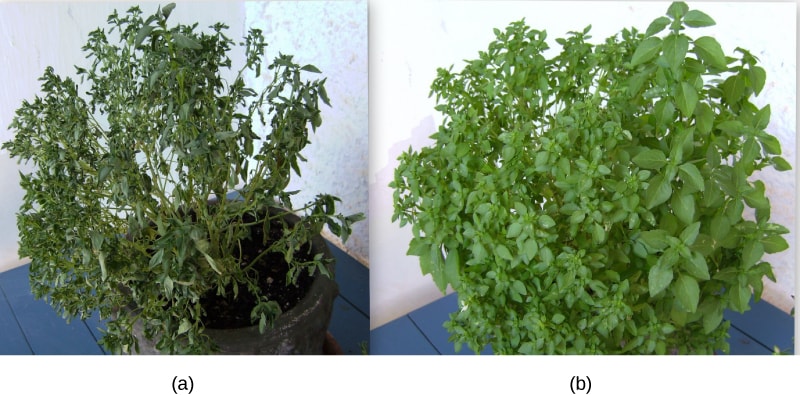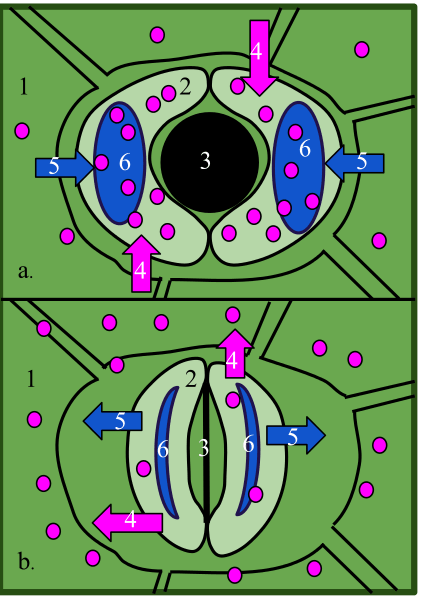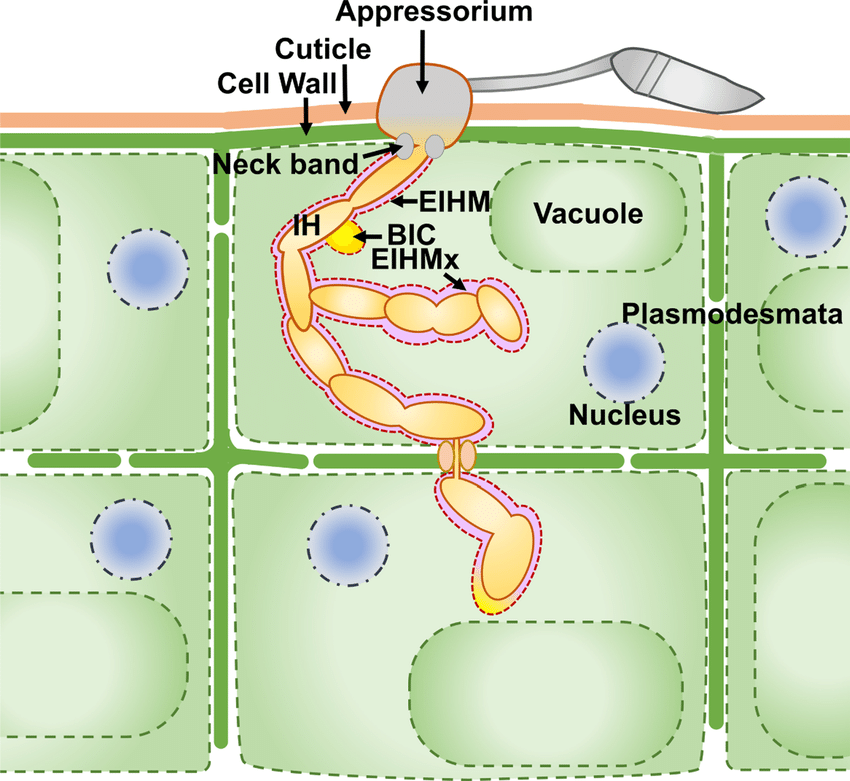
Turgor pressure
n., [ˈtɜːɡə ˈpɹɛʃə(ɹ)]
Definition: pressure that is exerted by the fluid (e.g. water) against the cell wall
Table of Contents
In biology, turgor pressure pertains to the pressure that is exerted by the fluid (e.g. water) against the cell wall. It is also referred to as hydrostatic pressure. (1) The pressure in a liquid at rest can be measured by the density of the liquid, the acceleration of gravity, and the depth of the fluid column. (2)
When the pressure from the fluid involves water as a result of influx across a semi-permeable membrane, it is referred to as osmotic pressure. Because of the differences in the solute concentrations between solutions, water diffuses to where there are more solutes. This tendency of water to move from one area to another is called ‘’water potential’’. When water moves into the cell, the cell becomes turgid. The condition wherein the cell is turgid or swollen is called turgidity.
Turgor pressure is key to the plant’s vital processes. It makes the plant cell stiff and rigid. Without it, the plant cell becomes flaccid. Prolonged flaccidity could lead to the wilting of plants. Turgor pressure is also important in stomate formation. The turgid guard cells create an opening for gas exchange. Carbon dioxide could enter and be used for photosynthesis. Other functions are apical growth, nastic movement, and seed dispersal.
Turgor Pressure Definition
What is turgor pressure? In a biological context, turgor pressure is the pressure that is exerted by water on the wall of a cell. Think of a balloon that is being filled up with water as a turgor pressure example. The balloon swells as more water draws in. The pressure that the water exerts against the walls of the balloon is similar to the turgor pressure exerted against the wall.
Etymology
The term turgor comes from Latin turgēre, meaning “to be swollen”. The term pressure comes from Latin pressūra, pressus, premere, meaning “to press”. Turgor pressure is also called hydrostatic pressure, pressure potential, or wall pressure.
Turgor Pressure and Osmosis
In nature, the cell regulates water movement. Water molecules diffuse across a biological membrane. This passive movement of water molecules across the membrane from an area of low solute concentration to an area of high solute concentration is called osmosis. In another definition, osmosis refers to the net movement of water molecules through a membrane from an area of higher water potential to an area of lower water potential. A positive net movement of water into the cell is what causes turgidity. In animal cells, excessive osmosis could lead to the bursting of the cell. In plants, the cells will not burst. In fact, plant cells need turgor for structural integrity and rigidity.
Turgor Pressure in Plants

How does a plant cell control its internal turgor pressure? Looking at the cellular level, the plant possesses features that enable it to regulate the internal turgor pressure. They have cell walls that protect their cells from cell lysis (bursting) during high water influx. Their cell has a vacuole that is relatively larger than any subcellular component. The vacuole incites water influx through osmoregulation.
Cell wall
The plant cell wall accounts for the turgidity and the rigidity in plants. The cell wall protects the plant cell from bursting due to the influx of water. Rather than bursting, the cell is able to withstand the osmotic pressure exerted by the water molecules. Consequently, the cell is kept turgid. Some plant cells have a cell wall comprised of a single layer. Other plant cells have two: primary and secondary cell walls. The second cell layer is high in lignin and therefore helps waterproof the cell.
Plants show turgor pressure when their cells are turgid from the pressure exerted by water molecules against the cell wall. Their cell wall keeps it from bursting despite significant water influx as opposed to an animal cell that would. The animal cell has only a cell membrane whereas plant cells have both. The cell wall serves as a protective layer around the cell membrane. It helps resist osmotic pressure, which arises due to the osmotic flow of water driven by the differing amounts of solutes between extracellular fluid and intracellular fluid.
The plant cell wall is a tough, rigid structure that is comprised mainly of cellulose. It may be a single or a double layer of cellulosic material. As the plant cell matures, the first cell wall (called the primary cell wall) secretes a secondary cell wall below it and on top of the cell membrane. The ‘’secondary cell wall’’ is distinctively rich in lignin deposits, which helps to waterproof the cell.
Osmoregulation by vacuoles
Osmoregulation is the process of regulating water potential so that the osmotic pressure inside the cell is kept within the optimal range. It is through which a cell maintains a suitable concentration of solutes and amount of water inside the cell with respect to the surrounding fluid. As earlier noted, water potential is the ‘’tendency’’ of water to move from one area to another. Water potential in plants can be prompted through osmoregulation and the cytoplasmic structure that is key to this biological process is the vacuole.
A plant vacuole is a large membrane-bound vesicle in the cytoplasm. The vacuole contains water, inorganic molecules, and organic molecules. It maintains turgor pressure by regulating the osmotic flow of water. It could take up or store ions, sugars, and other solutes. This makes the intracellular fluid hypertonic with respect to the extracellular fluid (which, in this case, is hypotonic relative to the cell). Since there are more solutes inside the cell than the extracellular fluid, water draws in. The positive net influx of water results in osmotic pressure or turgor pressure.
Tension
While plant cells have a cell wall that protects them from massive water influx in which the animal cells are susceptible to, their cell wall cannot protect them against drought or water deficiency. Without adequate water in the extracellular fluid, water molecules will tend to move out of the cell and thus cause a neutral or negative net water movement, thus a relatively low turgor pressure. A plant cell in an isotonic fluid could lose its turgor pressure and become flaccid. When prolonged, the plant would eventually look unwell and wilted. The condition could be corrected with the availability of sufficient water.
Turgor pressure and stomates

Stomates are the tiny pores in plants that allow gas exchange. They are typically found on the surface of the lower epidermal layer of the leaf. They may also be seen on certain stems of plants. The stomates are, in fact, openings formed when two guard cells are open. The two guard cells create an opening when they are turgid. The osmotic pressure draws water in and as a result, causes the guard cells to increase in volume, or essentially, to swell. The swelling causes the guard cells to bow apart from each other as the inner wall of the pore is more rigid than the wall on the opposite side of the cell. The opening that is created by the turgid guard cells is vital to the function of stomates. Through these openings, it provides a way for carbon dioxide to enter. Carbon dioxide is one of the reactants in photosynthesis. Oxygen, in turn, is one of the byproducts of photosynthesis and plants discard it also via the stomates.
Negative turgor pressure
While the turgor pressure in most cells is inherently positive, it is negative in the xylem of a transpiring plant. (3) This is not surprising since the xylem is a vascular tissue responsible for the conduction of water and nutrients from the roots up to the shoots and leaves. When the plant transpires, it loses water by evaporation. The water vapor leaves via the stomates. The loss of water through transpiration causes high surface tension and negative turgor pressure in the xylem. This enables water from the roots and then up to the apical parts of the plant.
Function of Turgor Pressure in Plants
Rigidity
Turgor pressure is vital to plants, especially to those who live in a terrestrial habitat. This pressure provides them the needed turgidity and rigidity that could help them stay upright against the force of gravity while poising themselves toward the source of light.
Stomates formation
Since turgor pressure is what the guard cells make use of to create stomates, then it is crucial to transpiration, water movement, and photosynthesis.
Nastic movements
Some plants use a similar mechanism employed by stomates to assume a sleeping position at nighttime. During the day, these plants are upright to collect light for photosynthesis. At night, their leaves and flowers close and droop, assuming a sleeping position. This movement (called nyctinasty, a form of nastic movement) apparently is associated with the pulvinar cells at the base of a plant leaf (or leaflet) or at the apex of the petiole. This drooping of plants is also seen in Mimosa pudica wherein the leaves lose while pulvinar cells gain turgor pressure in response to touch.
Apical growth
Turgor pressure in plants is also implicated in growth. The cell wall expands with the pressure. Accordingly, this pressure is responsible for the apical growth of root tips. (4)
Seed dispersal
In Ecballium elaterium (squirting cucumber), turgor pressure is used for seed dispersal. The pressure build-up inside the fruit causes the fruit to detach from the stalk. As a result, the seeds and the water inside are ejected as the fruit falls off the ground. Accordingly, the pressure within the fruit is between 0.003 to 1.0 MPs.(5)
Watch this vid about Turgor Pressure
Turgor Pressure in Non-Plant Organisms
Regulating turgor pressure is essential not just in plants but in other organisms as well. Here are examples:
Bacteria
Bacteria, especially with cell walls, are able to prevent lysis, owing to their rigid cell wall. A bacterial cell wall, though, is different from a plant cell wall by being made up primarily of peptidoglycan. Despite the difference, both bacteria and plant cells have walls that effectively resist cell lysis during an excessive water influx.
- By modifying their cell walls, bacteria regulate turgor pressure as follows:
- In a hypertonic environment, they tend to add more peptidoglycan layers to prevent too much water loss.
- In a hypotonic environment, they degrade a portion of their cell wall to facilitate easy water influx.
- Another strategy is to produce osmoprotectants (osmolytes), which are organic compounds employed to increase the concentration of solutes in their cytoplasm, thereby countering the osmotic pressure in their surrounding medium.
- Some bacteria tend to release polysaccharides that will coat and protect the cell from losing water loss and help maintain turgor pressure in harsh environments.
- By modifying their cell walls, bacteria regulate turgor pressure as follows:
Protists
Plant-like protists, like algae, have cell walls that are essentially likened to plants as both of their cell walls contain cellulose. However, there are structural differences, e.g., some algal cell walls (e.g., diatoms‘ cell walls) have silica or calcium carbonate (calcareous algae), which are not generally found in plant cell walls.
Turgor pressure is regulated in algae via osmoregulation, which entails various mechanisms, such as ion transport (by employing active transport systems and ion channels), osmolyte production, and vacuolar machinery.
Fungi
Fungal cell walls are primarily made up of chitin, a complex sugar. Chitin renders a strong barrier that prevents water from leaving the cell, especially when in a hypertonic environment. Similar osmoregulatory mechanisms are involved, such as ion transport, osmolyte production, and vacuole systems. Turgor pressure is essential to fungi as it is used in maintaining their cell shape, nutrient uptake, reproduction (in discharging spores), and penetrating host cells and/or substrates.

Try to answer the quiz below to check what you have learned so far about turgor pressure.
Further Reading
References
- Keith, R. (2007). Handbook of Plant Science, Volume 1. John Wiley & Sons.
- Hydrostatic Pressure. (2010). Retrieved from Engineeringtoolbox.com website: https://www.engineeringtoolbox.com/hydrostatic-pressure-water-d_1632.html
- “pressure potential.” A Dictionary of Ecology. Retrieved from Encyclopedia.com: https://www.encyclopedia.com/science/dictionaries-thesauruses-pictures-and-press-releases/pressure-potential
- Shimazaki, Y., Ookawa, T., & Hirasawa, T. (2005-09-01). “The Root Tip and Accelerating Region Suppress Elongation of the Decelerating Region without any Effects on Cell Turgor in Primary Roots of Maize under Water Stress”. Plant Physiology. 139 (1): 458–465.
- Kozlowski, T.T. (2012). Seed Biology: Importance, Development and Germination. 1. Academic Press. pp. 195–196.
© Biology Online. Content provided and moderated by Biology Online Editors





